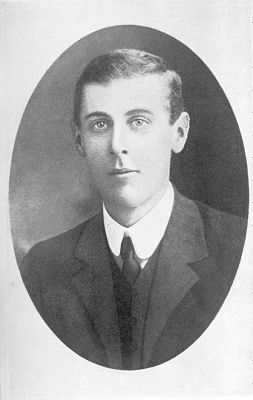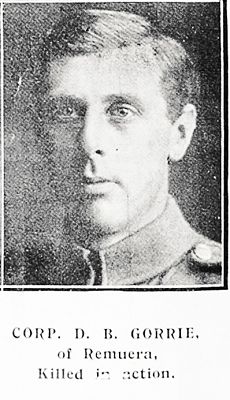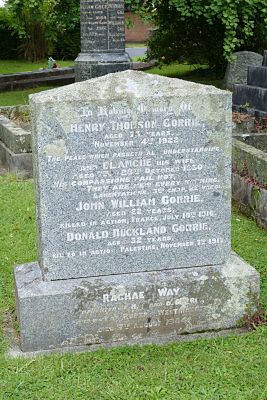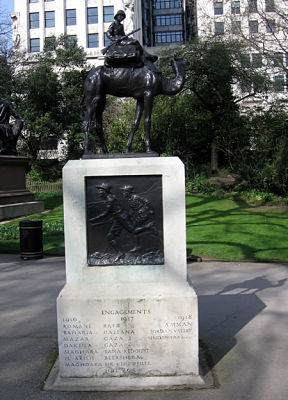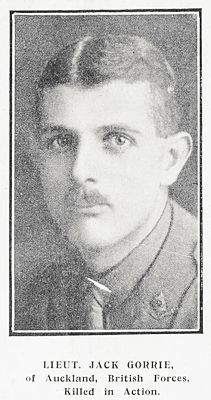WW1 Trooper Donald Buckland Gorrie 17583 and Lieut. John (Jack) Gorrie
Donald Buckland Gorrie was born on 6 April 1887 to Blanche (nee Buckland) and Henry Thomson Gorrie of Highwic and Dunkerron in Remuera and Epsom. He attended King’s College and although some records say he attended Auckland Grammar School, no evidence can be found to support this.
After leaving college, he joined the firm of Alfred Buckland (his mother’s father) and Sons, of which his father was the principal, as an auctioneer. He married G(w)ladys Eileen West in 1912 and had a daughter Lesly in 1913. They lived in Alfred St Remuera and at 10 Patey Street, Remuera. [1]
On attestation on 16 April 1916, Donald was promoted to Lance-Corporal on 6 May 1916, but relinquished his rank at his own request on 11 December 1916. He left New Zealand on 5 Oct 1916 on the Manuka with the New Zealand Mounted Rifles of the 17th Reinforcements, transferred to the Morea in Sydney, arriving in Suez on 14 November 1916. After training at Moascar, Egypt, he transferred to the Imperial Camel Corps (16th Company) on the 15 December 1916. [2]
Donald was present at the Battle for Beersheba (officially called the Third Battle of Gaza) at the end of October 1917. The Auckland Mounted Rifles Regiment “remained, consolidating Saba until 2 November while the brigade’s other regiment and the 4th Squadron were fighting a Turkish cavalry force. On 4 November the brigade moved to Wadi El Sultan. The next day the 4th Squadron was tasked to support the Canterbury Mounted Rifles, advancing against a Turkish position eight hundred yards (730 m) away. The Turks counter-attacked the Canterbury Mounted Rifles, so the 3rd Squadron was moved forward to support them and the attack was defeated. The regiment lost one man dead and four wounded during the day’s fighting. While the rest of the brigade retired to the west, the regiment remained at the front manning observation posts until 11 November, when they were relieved by the British Westminster Dragoons.” [3].
Donald Gorrie was killed in action on the 7th November 1917. His obituary said: Trooper Donald B. Gorrie, eldest son of Mr. H. T. Gorrie, of Auckland, has been killed in action in Palestine. Trooper Gorrie, who was about 32 years old, was married, and is survived by his widow, formerly Miss West, and a five-year-old daughter. He was educated at the Auckland Grammar School and King’s College. On leaving the latter he joined the firm of Alfred Buckland and Sons, of which his father is the principal, and entered the auctioneering branch. He enlisted about 18 months ago, and went to Egypt as a member of the Camel Corps, but at the time of his death was serving with the Mounted Rifles. He was a thorough sport, and took a keen interest in horses, being a polo-player and always following the hounds with the Pakuranga Hunt Club. His younger brother, Lieutenant Jack Gorrie, who went Home early in the war and enlisted in an Imperial regiment, was killed in France on July 19, 1916. [4]
Donald Gorrie is remembered on the following memorials:
• Jerusalem Memorial, Jerusalem War Cemetery, Israel
• Mt Roskill War Memorial, War Memorial Park, 13 May Road, Mt Roskill, Auckland
• Auckland War Memorial Museum, World War 1 Hall of Memories MEMORIAL REFERENCE Panel 1
• St. Andrews Epsom Church exterior (Roll of Honour now held in St. Andrews Church, Howick). 100 St. Andrews Rd, Epsom, Auckland 1023. Image provided by John Halpin 2012, CC BY John Halpin
• King’s College Chapel,
Golf Ave, Otahuhu, Auckland 1640
• Imperial Camel Corps Memorial, Victoria Embankment Gardens, City of Westminster, London WC2N 6PB
Three brass tablets, placed in St. Andrew’s Church, Epsom, in memory of soldiers formerly resident in the parish, were unveiled at the morning service yesterday by the vicar, Rev. J. Wilkinson. The three soldiers commemorated are Lieutenant John William Gorrie, Worcester Regiment, killed in action in France in July, 1916, aged 22; Trooper Donald Buckland Gorrie, N.Z. Camel Brigade, killed in action in Palestine last November, aged 31; Second-Lieut. Evelyn Jack Rose, Auckland Infantry, killed in action in France last October, aged 23. The two former were sons of Mr. H. T. Gorrie, Buckland Road, and the latter was a son of Mr. Robert Rose, Gladwin Road. The congregation at the service filled the church. The vicar delivered an appropriate sermon, and at the end of the service the “Dead March” was played and the “Last Post” sounded. [5]
In 1930 his mother gifted two stained glass windows in the King’s College Chapel, commemorating her two sons Donald and Jack (John William) Gorrie, who was killed in July 1916 at the battle of the Somme in France.
ROLL OF HONOUR. CAREERS OF THE FALLEN. LIEUTENANT JACK GORRIE. A cable was received today by Mr. H. T. Gorrie, of Messrs. Alfred Buckland and Sons, stating that his younger son, Lieutenant Jack Gorrie, had been killed in action in France. Lieutenant Gorrie had not long left school when the war broke out, and he was one of the first of several Aucklanders who went Home to enlist. Soon after his arrival he went into training, and was given a second-lieutenant’s commission in the Royal Worcesters. He had been in France for several months. Lieutenant Gorrie was educated at King’s College, Remuera, and he was very well known in Auckland, particularly in hunting circles. He was a very fine type of young New Zealander, and the news of his death will be received with regret by his many friends. Mr. Gorrie’s eldest son (Mr. Donald Gorrie) is a non-commissioned officer in the 21st Reinforcements, and is now at Trentham undergoing training. [6]
MEMORIAL WINDOWS. KING’S COLLEGE CHAPEL. UNVEILING AND DEDICATION. Another stage in the beautifying of the King’s College Memorial Chapel was reached with the unveiling on Sunday of two stained glass windows, the gift of Mrs. H. T. Gorrie, sen. Placed on the north side of the chapel, they represent the marriage feast at Cana in Gallilee and the healing of the Centurion’s son, and are in memory of her two sons who were killed on active service. The inscriptions are:—”To Donald Buckland Gorrie, 7th November, 1917,” and “To John William Gorrie, 19th July, 1916.” The windows are the work of Mr. A. L. Ward, of London. The windows were unveiled on behalf of Mrs. Gorrie by Mr. C. T. Major, formerly headmaster of the college, and dedicated by the Rev H. K. Archdall, the present headmaster Mr. Archdall said it was a serious mistake to treat the windows of a church as mere decoration, not in any living relation with the faith and practice of those who worshipped near them. In the King’s College chapel, when completed, there would be a miniature of the Christian faith and a poem of the Christian life, in the windows about which generations of boys would have the opportunity of meditating The story of the sacrifices commemorated would not end until it had been answered by lives inspired by the noble examples of those who died. [7]
KING’S COLLEGE CHAPEL. ANOTHER WINDOW READY. THE EIGHT MIRACLES SERIES, [From our own correspondent.] LONDON, June 13. For the north aisle of the King’s College Memorial Chapel, Mr. Arthur L. Ward, the famous artist in stained glass, has produced” a series of windows illustrating the parables. The four windows on the south side are to illustrate eight of the miracles and the first window {of two lights) is now ready for shipment to Auckland. The work is fully up to the standard of that already in place in the chapel—the colouring just as beautiful and the designs just as interesting. The first miracle —turning the water into wine at the marriage feast of Cana of Galilee —is illustrated on the left light. At the back of the picture are the bride and bridegroom and the guests seated at a table laden with fruit and wine. Some exquisite colouring is obtained from the green robe of a serving maid und from the tablecloth and the purple carpet. The figures in the foreground of the picture represent Christ blessing the water as a slave lad pours it from one set of vessels to another. The Virgin, who stands watching the ceremony, is clothed in rich blue robes, while the robes worn by the principal figure are blue, red and white. The right-hand light illustrates the Roman centurion appealing to Christ to heal his servant. On the left of the group is a body-servant carrying a lance. The colouring of his attire is blue and steel. The kneeling centurion is clothed in purple and yellow, with a touch of green, and the Christ is wearing a robe of blue, white and green. St. Peter is seen on the right clothed in a purple robe. In the foreground is a group of flowers with symbolic meaning. The wild geranium is for steadfast purity, the Christmas rose for relief of anxiety, the snowdrop for hope and the mustard flower for the diffusion of the knowledge of the Gospel. Beyond the figures is a winding road leading to a distant city. The road is flanked with trees, which again are chosen for their symbolic meaning. There is the lilac, indicating humility, the pine tree pity, and the plum tree fidelity. The rich colourings in both the pictures are chosen to form a complete and balanced harmony. The inscriptions below the window read: To Donald Buckland Gorrie, 7th November, 1917. To John William Gorrie, 19th July, 1916. [8]
